The full moon on April 15th, will also coincide with a Total Lunar Eclipse, which will be mostly visible in the Western Hemisphere. Keep in mind that there will be 4 eclipses in 2014, 2 solar and 2 lunar.
Here are the 2014 dates:
2014 Apr 15: Total Lunar Eclipse
2014 Apr 29: Annular Solar Eclipse
2014 Oct 08: Total Lunar Eclipse
2014 Oct 23: Partial Solar Eclipse
Here are the 2015 dates:
2015 Mar 20: Total Solar Eclipse
2015 Apr 04: Total Lunar Eclipse
2015 Sep 13: Partial Solar Eclipse
2015 Sep 28: Total Lunar Eclipse
Note that the four upcoming Lunar Eclipses are all "Total Lunar Eclipses" !! This set of four consecutive total lunar eclipses is known as a "Tetrad" - NASA has a great facts about how rare this particular sequence of total lunar eclipses is!
"The lunar eclipses of 2014 are the first of four consecutive total lunar eclipses - a series known as a tetrad. During the 5000-year period from -1999 to +3000, there are 4378 penumbral eclipses (36.3%), 4207 partial lunar eclipses (34.9%) and 3479 total lunar eclipses (28.8%). Approximately 16.3% (568) of all total eclipses belong to one of the 142 tetrads occurring over this period (Espenak and Meeus, 2009). The mechanism causing tetrads involves the eccentricity of Earth's orbit in conjunction with the timing of eclipse seasons (Meeus, 2004). During the present millennium, the first eclipse of every tetrad occurs sometime from February to July. In later millennia, the first eclipse date gradually falls later in the year because of precession."
See more from NASA.gov HERE:

6 to 10 Temp Outlook
According to NOAA's CPC, the 6 to 10 day temperature outlook, the eastern part of the country sill has a shot at below average temperatures through the middle part of April, while the western part of the country will remain well above average.

3-7 Day Hazards
This is an interesting map from NOAA, which shows the potential weather hazards over the next 3 to 7 days across the nation. Note that the Upper Midwest/Great Lakes Region will have much below normal temperatures, while the eastern third of the nation is expected to get heavy rain/precipitation. Meanwhile, severe drought continues in the Southwest and Plains. Unfortunately, coupled with high winds in the Southern Plains, fire danger could be a common issue here.
See more from NOAA HERE:
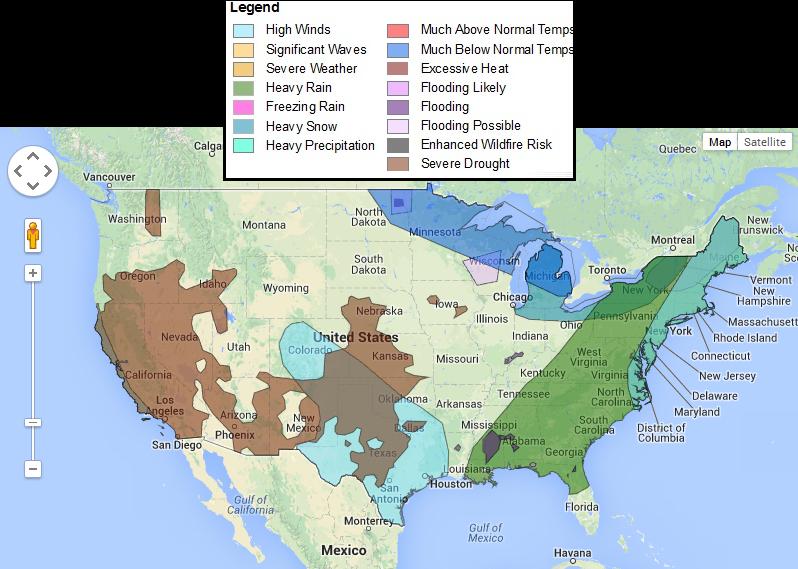
Turning Colder
Memories of March continue as we head into early next week. Take a look at the huge dip in the upper level winds as we head into early next week. This weather feature will draw down significantly colder than normal air for this time of the year. This "stormy" pattern will also help to bring more widespread precipitation to places in the central and eastern part of the country.

Highs Monday
Here's a glance at Monday temperatures and note how cold it looks in the central part of the country!
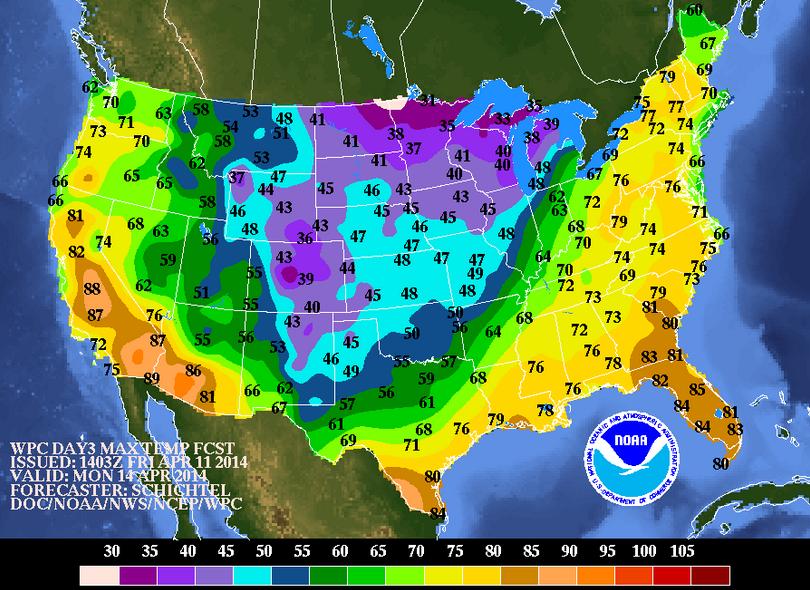
Highs From Normal Monday
For April standards, Monday will be significantly colder than normal in the central part of the country. In fact, temperatures may be a good 10F to 20F below average!
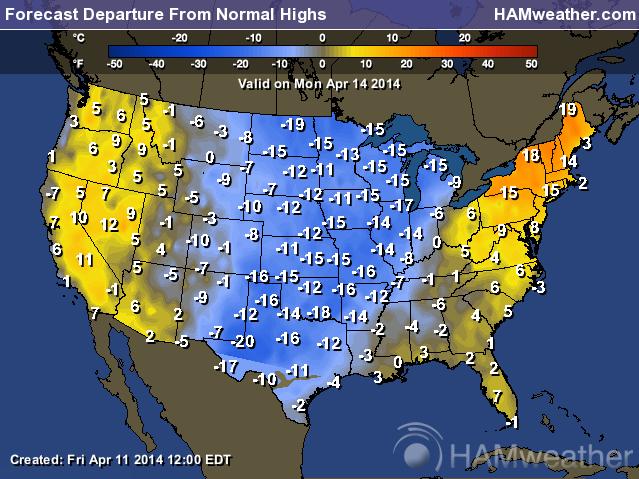
Highs From Normal Tuesday
By Tuesday, this colder air will be in place across the eastern two-thirds of the nation!
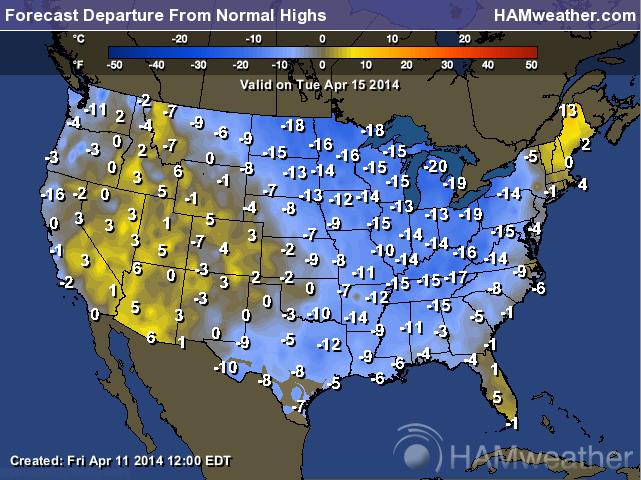
Weather Outlook
The colder air moving into the eastern two-thirds of the nation by early next week will be dropping in on the backside of a developing storm system. Take a look at the weather loop below and note the storm system in the Midwest/Great Lakes Region by Sunday. Also note the wintry precipitation on the northern and western flank of this developing storm.
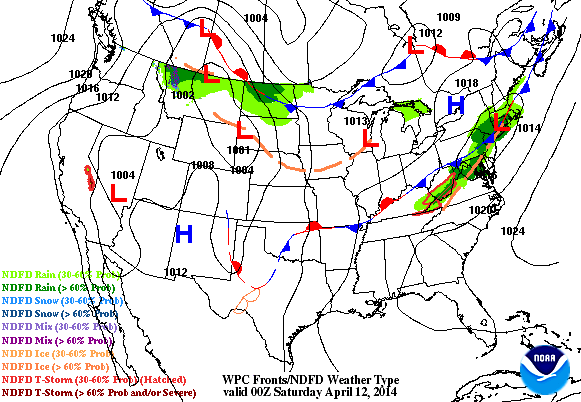
Weather Outlook Continued
Here's another look at the developing storm system as it develops through early next week. This classic looking spring storm will likely bring accumulating snow to some and severe weather to portions of the central part of the country.
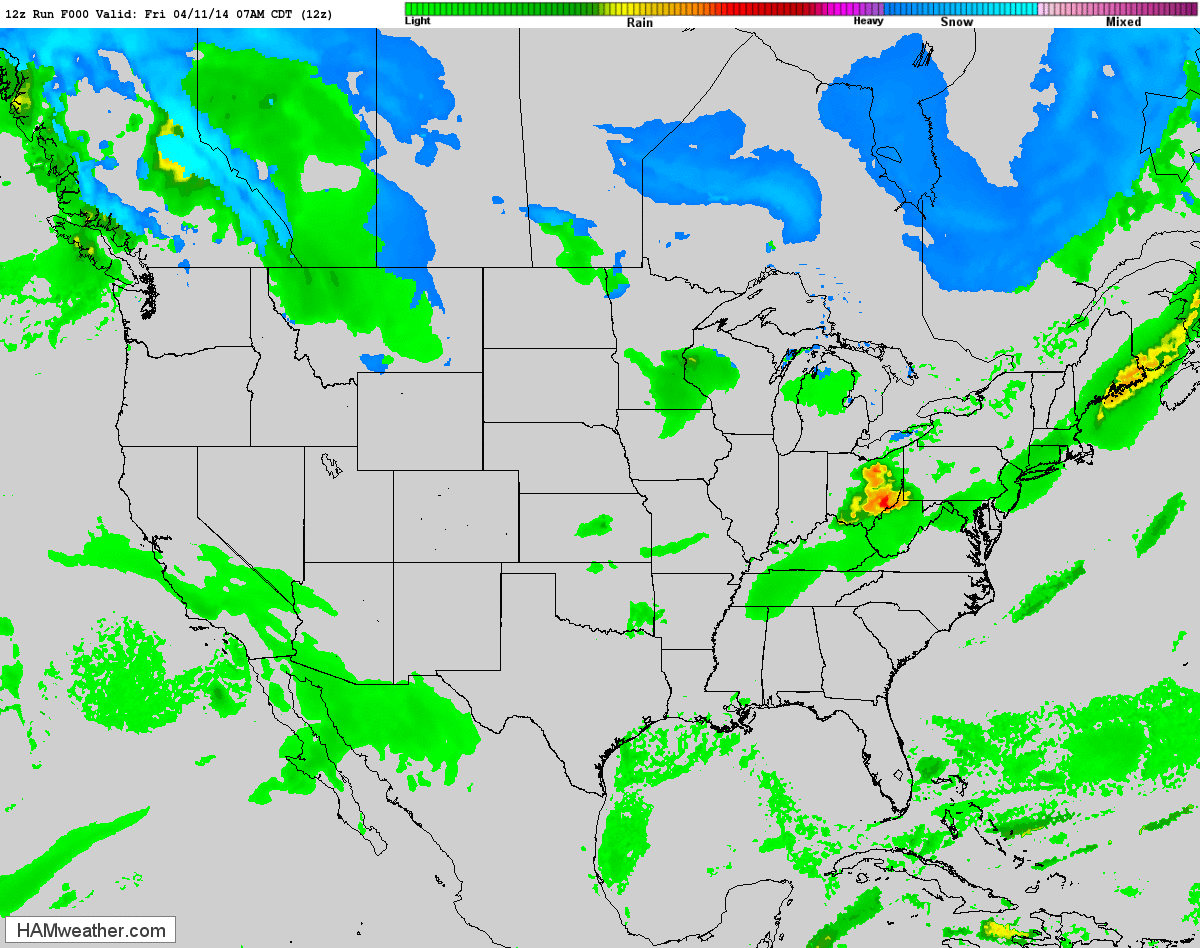
Precipitation Outlook
According to NOAA's HPC 5 day precipitation outlook, the developing storm system from late weekend into early next week looks to bring significant moisture across parts of the eastern half of the country. The Midwest/Great Lakes and portions of the Gulf Coast States could see the heavies tallies, which could also be conducive of flooding.
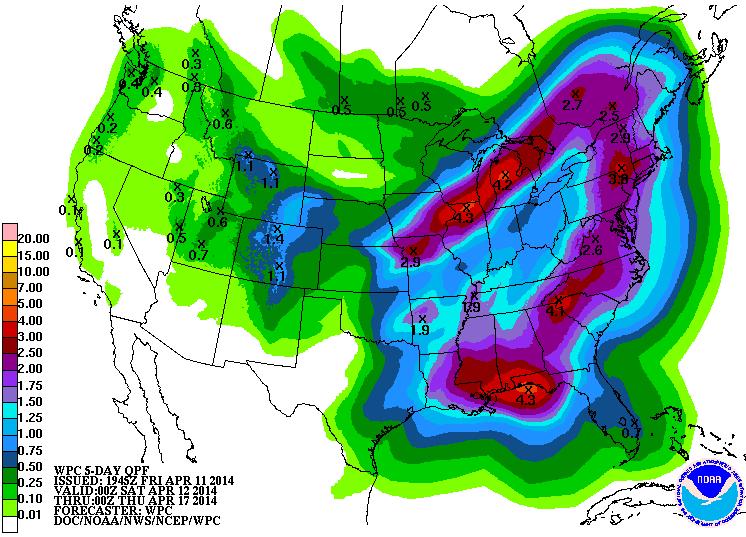
Severe Threat Saturday
The severe threat Saturday looks fairly minimal, but there appears to be enough instability during the PM hours along the leading edge of a cold front as it moves southeast through the Midwest. Hail and high winds look to be the primary threat with this particular system.
THE MOST PROBABLE REGION FOR DIURNAL STORMS SHOULD BE FROM THE UPPER MS VALLEY TO CNTRL GREAT LAKES IN ASSOCIATION WITH A LEAD SHORTWAVE IMPULSE AND CYCLONE. A CLUSTER OF ELEVATED CONVECTION SHOULD BE ONGOING AT 12Z/SAT ON THE NOSE OF A ROBUST SWLY LLJ. MOISTURE TRANSPORT SHOULD YIELD SURFACE DEW POINTS INCREASING INTO THE 50S TO AT LEAST SRN WI AND IL. SURFACE-BASED DEVELOPMENT SWWD ALONG THE FRONT/TRAILING OUTFLOW SHOULD OCCUR BY LATE DAY FROM CNTRL IA NEWD. STRONG DEEP-LAYER SHEAR AND STEEP MID-LEVEL RATES WILL PROMOTE ROTATING UPDRAFTS CAPABLE OF ALL SEVERE HAZARDS. BUT WITH MEAN WINDS GENERALLY PARALLELING THE FRONT...LINE-ORIENTED CLUSTERS SHOULD BECOME THE PREDOMINANT MODE WITH SEVERE HAIL/WIND AS PRIMARY HAZARDS.

Sunday Severe Threat
By Sunday, our main area of low pressure will begin to move into the central part of the country, so the dynamics begin to become more interesting. Severe weather concerns will be ramping up by PM Sunday and Monday as the storm takes shape a little more. At this point, there is a large section of the middle part of the country that could see strong/severe storms on Sunday.
AS THE AIR MASS DESTABILIZES THROUGH AFTERNOON...AMPLE FORCING FOR ASCENT TIED TO THE AFOREMENTIONED SHORTWAVE TROUGH AND COLD FRONT SHOULD INFLUENCE INCREASING TSTM DEVELOPMENT PARTICULARLY SUNDAY AFTERNOON/EVENING. GREATER CERTAINTY FOR STRONGER DEEP CONVECTIVE DEVELOPMENT WILL BE NEAR THE ADVANCING COLD FRONT ACROSS PARTS OF OK/SOUTHEAST KS AND ADJACENT MO/KS. HOWEVER...OTHER MORE DISCRETE STRONG/SEVERE STORMS INCLUDING SUPERCELLS WILL BE POSSIBLE ACROSS ADDITIONAL PARTS OF EAST-CENTRAL TX/ARKLATEX WITHIN THE PRE-FRONTAL WARM SECTOR AND NEAR THE DRYLINE EXTENDING SOUTHWARD ACROSS SOUTH-CENTRAL OK INTO NORTH-CENTRAL/CENTRAL TX. FAVORABLE WIND PROFILES WILL SUPPORT INITIAL SUPERCELLS...ALTHOUGH INCREASINGLY UNIDIRECTIONAL WINDS /VEER-BACK-VEERING WINDS WITH HEIGHT/ AND THE INFLUENCE OF THE COLD FRONT SUGGEST THAT MULTICELLS/LINE SEGMENTS SHOULD EVOLVE DURING THE EVENING IN MOST AREAS...WITH NEAR-COLD FRONTAL STORMS STEADILY BEING UNDERCUT BY THE COLD FRONT /FROM NORTHWEST TO SOUTHEAST/. LARGE HAIL IS EXPECTED TO THE PRIMARY HAZARD OVERALL...ALTHOUGH DAMAGING WINDS AND SOME TORNADOES MAY BE POSSIBLE AS WELL.
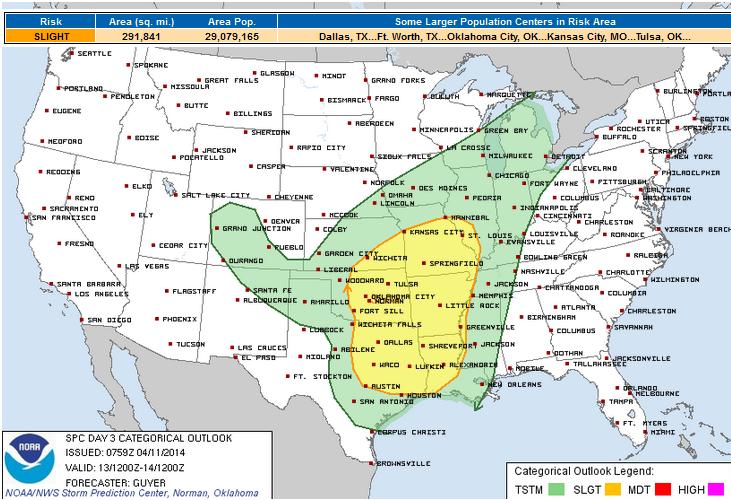
Winter Weather Potential
There is a growing snow potential for a number of locations through Monday evening. The graphic below suggests the probability of at least 2" of snow or more. Note that areas along the Rockies/Front Range have the best potential. Note how there is also a fairly decent chance that some light accumulations may be possible across parts of the Midwest/Great Lakes Region and also across the international border.

Probability of 8"
The probability of at least 8" of snow or more drops significantly over this time, but the best chance still exists over the higher elevations in the Central Rockies.
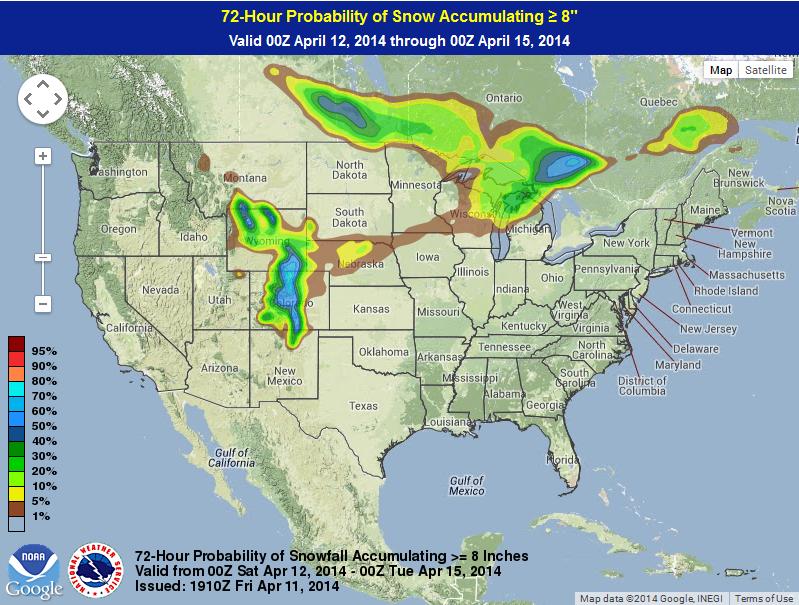
Snow Potential
Here's the GFS (American model) suggested snowfall accumulation through AM Tuesday.
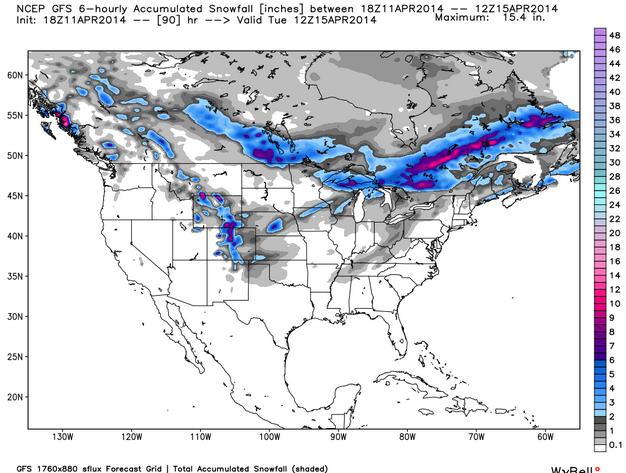
Mystery on Mars?
NASA's Mars Rover Curiosity captured a pretty interesting beam of light earlier this week. There have been several conspiracies out there, but NASA suggests that it is likely sun glint!
"In a NASA news release late on Tuesday, a member of the team that built and operates the rover’s Navigation Camera (Navcam) outlined the most likely causes of the bright dot — a feature that isn’t all that rare in Curiosity’s raw imagery beamed back to Earth.
“In the thousands of images we’ve received from Curiosity, we see ones with bright spots nearly every week,” said Justin Maki of NASA’s Jet Propulsion Laboratory, Pasadena, Calif. “These can be caused by cosmic-ray hits or sunlight glinting from rock surfaces, as the most likely explanations.”
This official word builds on the preliminary theories as to what the bright dot is in a photo taken on Sol 589 (April 3) of Curiosity’s mission."
Read more from Discovery.com HERE:

Thanks for checking in and have a great weekend ahead! Don't forget to follow me on Twitter @TNelsonWNTV
